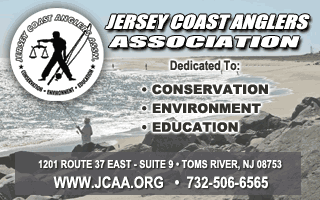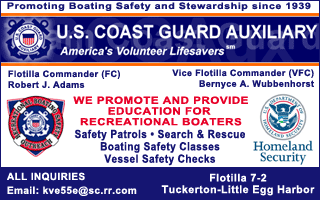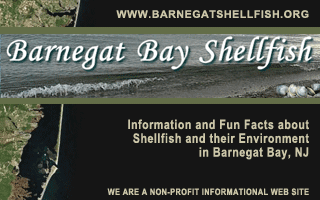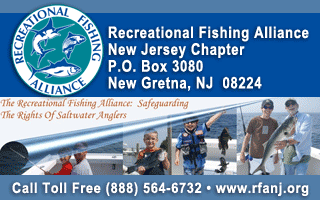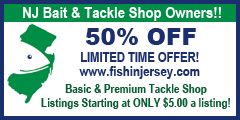

Knowing what the bass are chasing and selecting a matching lure and technique is certainly the way to land more bass...
by Michael Melchionne
As a fisherman in New Jersey there are few times of the year that rival the anticipation of Christmas Eve. One of those periods is the weeks, and then the days just prior to the striped bass migration (Fall Run!). The onset of fall brings some terrific fishing close enough to home that guarantees to excite just about anyone willing to put their time on the water. At this time of year you need to be observant and able to adapt to what clues are telling you!
The Fall is when all of our back water ponds, rivers, and bays filter through our ecosystem and nature dances to temperature changes, weather fronts and daylight changes. The numerous baitfish who have entered these same back waters in the spring and summer have done what instinct has caused them to do. They have bred, laid their spawn, and assured the continuance of their species. Fall is the time for them to seek a more appealing environment as they leave these fair weather haunts. And when they do, they do so in massive numbers. In order to be a successful striped bass fisherman you need to understand what particular diet the stripers prefer at that moment in time and try to imitate it the best you can. Fresh water fly fisherman have known this for years. You need to “match the hatch”! What are these particular fish feeding on?
Game fish, like most marine species, are opportunist. Striped bass are no exception. In fact striped bass are kind of lazy most of the time and don’t like to travel very far to eat. What they’re eating is your clue to what enticement you need to present to get one on the end of your line!
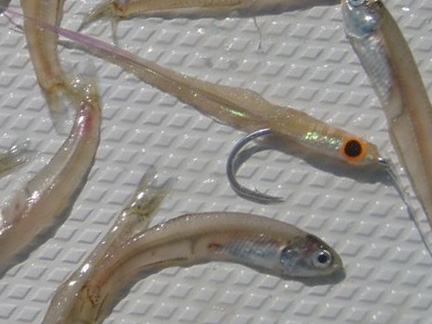 |
| The clues to "match the hatch" can be found when fish spit them on your boat's deck! |
Striped bass are relatively large fish running anywhere from 8-9 lbs. on up to an occasional 50 plus pounder! In fact our state record and the former world record striped bass weighed 78 lbs. 8ozs. This fish was caught in Atlantic City in 1982. In 2011 a fish from Connecticut was weighed in at 81 lbs. 14 ozs. And people wonder why some fisherman get crazy at this time of year?
Now your chances of catching a “big” bass, off land are just as good as catching one off a boat. Maybe even a new state record? But if you’re fortunate enough to have access to a boat, your odds will be greatly increased. By covering more ground and encountering different bodies of fish, you may set your hook in a world class bass just a wave or two from home.
Make Sure Your Tackle is up to the Job
To handle a large fish, you need to know your equipment. Your hooks, lures, leaders, swivels, line, pole, reel, net all have to be strong, in good repair, sharp and up for the task at hand. Local bait and tackle shops, (many of which advertise on www.fishinjersey.com) are very helpful in choosing the proper equipment and terminal tackle required. Even if you are an experienced fisherman you should consider joining one of the many fishing clubs throughout the state. They are the best way to “compare notes” with other anglers. Recently fellow editor Tom Vassallo and I attended the Cookstown Saltwater Anglers Club and listened to a seminar on “Striped Bass Fishing” given by Capt. Art Stokes. His mentor Capt. Chris DiStefano and also Capt. Al Ristori were in the audience giving away some “years of experience” on tackle and techniques. As they so poignantly stated even the newest and most expensive terminal tackle won’t work if your presentation doesn’t resemble the abundant natural forage!
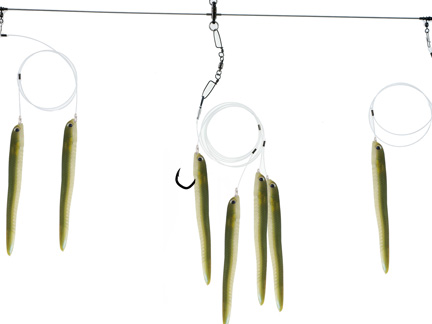 |
| Umbrella Rigs and other artificial lures should resemble the natural bait in the area. |
Structure and Current
Both are as important as the other. Structure provides confinement to hide from ones prey as well as from the elements. Large and small fish need both! Currents are just as important as larger fish usually face into the current when not in a feeding frenzy chasing bait schools around. Smaller bait fish riding the current provide occasional morsels to the waiting predatory fish as they’re presented to them. Even the laziest bass will be tempted if the food is close enough.
Trolling
Trolling for striped bass is one of the most popular methods to catch bass. To say that it is the easiest though is an understatement. Trolling for stripers is a specialized sport. It takes special rods and a different kind of line. Some poles are quite lengthy and flexible (bunker spoon rods). These rods are usually 8-10 feet long and specifically manufactured for a sole purpose. Stainless steel, lead core or the forgiving monel wire line is necessary for these longer trolling rods to pump the bunker spoons with the proper action to resemble an easy meal! A minimum of 300 feet of line is necessary. Some captains prefer 600 feet! The line should be marked at 100 feet and then at every 50 foot increment. This is how you regulate the depth of your spoon. An approximate rule of thumb is for every 100 feet of line equals 10 feet of depth. Of course this will vary depending on wind, current, speed, line weight etc;
Many people believe that you should only troll with bunker spoons in the spring as the bunker are more plentiful. Smaller bunker and herring are very common in the fall so you may want to adjust the size of you spoon to “match the hatch”. Colors vary, so if one isn’t working switch it up till you find the one that does. A fluorocarbon leader (minimum test of 50lbs.) is necessary, about the length of the pole and tied directly to a barrel swivel on the presentation side. On the other side of the swivel the wire is tied with a hay twist to securely fasten it to the line. I like the swivel to be about 150 lb. and small enough to slide easily through the guides! In the heat of the action you’ll see exactly what I’m talking about! NO trolling weights or drail’s should be used with wire line.
Trolling umbrella rigs on the other hand may require weight to get them down to the proper depths. Shorter heavier poles are necessary to handle the drag and weight of the umbrella rig. They need to be quite stout and strong! Monofilament or braid line (my preference) can be used. Umbrella rigs not only work well, BUT with the assortment of baits entering the ocean mullet, spearing, shad, herring, rain fish, anchovies, and sand eels can all be imitated with a little imagination. A center line a little longer (about 18 inches) with a long surgical tube, a squid or Clark Spoon trailing and flashing behind will sometimes entice a fussy eater!
Trolling speed depends on many factors. Winds, currents and tides, types of trolling rigs all matter. A general rule of thumb is to keep your speed between 2.5 and 4 knots. You’ll need to constantly adjust your throttle as conditions require.
Trolling direction matters and should vary. You will usually get more strikes trolling into the current. What’s your best guess telling you is going on down there? If you mark fish and don’t get a bite, turn around and troll over them from the opposite different direction. Just like the bait fish that ride the current! (try to match the hatch). No bites, try trolling sideways or perpendicular to them!
If that doesn’t works keep the spot marked and try it again on the way home. You just never know.
Jigging
Nothing can get the blood pumping more than pulling up to a flock of diving gannets or a group of boat searching feverishly or seeing fish surfacing in the middle of the mayhem. Before you start casting blindly into the middle take the time to determine what all the commotion is about. Are they feeding on tiny rain fish, peanut bunker, sand eels? Will an Ava with a tail work? What size, what color? How about the old reliable buck tail or lead head jig? Does it need feathers or some other dressing like pork rind, squid, a twister tail, colored tube or gulp?? How about a floating or diving plug? The choices are endless. Instead of wasting valuable time try first to determine what they’re feeding on. Then “match the hatch”
Like with all types of fishing there are rods made just for jigging. Yes your wife will never get “WHY” you need so many different rods! But calmly tell her, “ Hon, it’s like shoes, there’s one needed for every occasion”! I’ll bet you she gets it then!
I like to use at least a 7 foot pole with a medium to heavy action depending on the weight of my presentation. The heavier the jig, the stiffer your rod should be. Bigger is not always necessarily better when selecting the right jig.
Something to keep in mind is when fish are seen at all levels of the water column, stop and jig these fish as they are actively feeding and your lure has more opportunities to pass closely to a fish at all levels.
Also remember that just because you’re not seeing fish on the screen but your reading some real fishy structure or contour spend 5 minutes and throw a few jigs. You just never know!
Chunking and Chumming
At the right time and the right location meat, blood and guts will attract and catch more fish than any other method. I like to use this method on those days when the ocean is crowded with boats. The weekend warriors are splitting pods of fish left and right. On days like these it seems like everyone thinks that if they can just get to that water in front of you they’ll catch the fish first! The fish were actively feeding but are now scattered and down low. These are the times I like to get away from the fleet a little bit, cut up some baits we know the fish are feeding on and start a chum slick. Always up tide/current from where we know they were feeding. I save the choice pieces for the hook, usually a 7/0 and a 3 foot fluorocarbon 50 lb. leader. Depending on the conditions I use either a fish finder rig with a 1-3 oz. weight. Or an egg sinker above the swivel, again the weight depends on the conditions. When it’s fairly calm no weight at all is used. I like to start out with 3-4 poles out at different depths until we catch our second fish. At that point all lines go to the depth of the two fish. Don’t chum too heavily. If you do the fish will sit back and wait for the food to get to them. During the lulls in the action when the mate is sleeping on the chum line I’ve found that the fish actually follow the chum to the hooks and we get more strikes! If you have any live bait, drift one back in the slick. Keep feeding out line as needed.
Live Lining
One of the surest ways to entice a striper when all else fails is to offer it a live natural bait. At this time of the year from late October into December live spot, mullet, herring or eels will produce fish, if you can get them through the bluefish! Anywhere along the sod banks, around rock piles and jetty’s, over structure (stumps, snags) a live bait is the key to success.
Some of the most exciting and exhilarating striper fishing I’ve ever experienced is not for the in-experienced or faint hearted. In late October and November schools of 15-30 lbs. striped bass flood into our inlets and bays. They are headed south and feeding on everything they can find. After the sun goes down and throughout the night drifting live eels in the pitch dark produces fish of magnum size.
It’s cold, it’s dark, your captain needs to know his boat and equipment and how to use it. He needs to know the passable channels and the sandbars. Your bait is slippery, your hands are frozen as you lower you line with a fish finder set up or egg sinker (exactly like chumming). When your weight hits the bottom you need to turn the handle two cranks to keep it off the bottom and wait. When that line sider grabs your eel or spot and runs with your bait in its mouth, you’ll know it. In the dark, not sure of how far out the fish is you pray the hook doesn’t pull. But after the second or third run you’re focused and patient. When the fish gets close you’ll know it, you’ll hear it and see it. Some of us smell them! And when that net slips under your fish you’ll know why we’re here and do what we do.
Life is good when you’re on Jersey waters! "Match the hatch" and start putting more fish in the boat!




